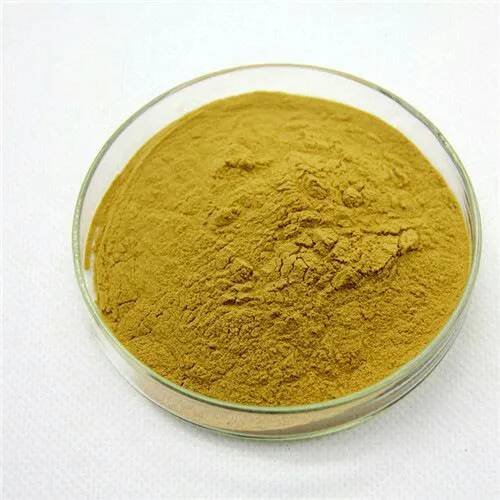- 0086-571-85302990
- sales@greenskybio.com
The Best Types of Echinacea Extract: A Guide to Selecting the Best Echinacea Extract.
2024-11-13

Introduction
Echinacea, a genus of flowering plants native to North America, has been used in traditional medicine for centuries. Echinacea Extract has gained significant popularity in recent years due to its potential health benefits, such as boosting the immune system, reducing inflammation, and fighting infections. However, with the variety of echinacea products available on the market, it can be challenging to select the best Echinacea Extract. This article aims to provide a comprehensive guide, considering factors like extraction methods, plant parts used, and quality standards.

Types of Echinacea
There are nine species of Echinacea, but the three most commonly used for medicinal purposes are Echinacea purpurea, Echinacea angustifolia, and Echinacea pallida.
Echinacea purpurea
Echinacea purpurea is perhaps the most well - known species. It is widely cultivated and has a relatively high content of active compounds. The plant has large, purple - pink flowers and is often used in herbal remedies. It is known for its immune - enhancing properties and is considered to be relatively gentle on the body.
Echinacea angustifolia
Echinacea angustifolia has a long history of use in Native American medicine. Its roots are the main part used for extraction. This species is believed to have potent anti - inflammatory and immune - modulating effects. However, it is less common in cultivation compared to Echinacea purpurea, which can sometimes make its products more expensive.
Echinacea pallida
Echinacea pallida also has a role in traditional medicine. It has narrow, pale - purple flowers and its roots and aerial parts are used for extraction. It contains certain unique compounds that may contribute to its health - promoting effects, such as antioxidant and antimicrobial activities.

Plant Parts Used for Extraction
Different parts of the echinacea plant can be used for extraction, each with its own set of characteristics.
Roots
The roots of echinacea plants, especially in the case of Echinacea angustifolia, are rich in active compounds such as alkylamides and polysaccharides. Extracts made from roots are often considered to be more potent in terms of their immune - enhancing and anti - inflammatory effects. However, harvesting roots can be more labor - intensive and may have an impact on the plant's growth and survival in the wild if not done sustainably.
Aerial Parts
The aerial parts, which include the stems, leaves, and flowers of the echinacea plant, are also used for extraction. For example, in Echinacea purpurea, the aerial parts contain a significant amount of flavonoids and phenolic acids. Extracts from aerial parts may have a broader range of antioxidant and immune - modulating activities. Additionally, using aerial parts can be more sustainable as it does not require uprooting the entire plant.

Extraction Methods
The method used to extract echinacea can greatly influence the quality and effectiveness of the final product.
Solvent Extraction
Solvent extraction is a common method. Ethanol or water - ethanol mixtures are often used as solvents. Ethanol is effective in extracting a wide range of active compounds from echinacea. The advantage of using a solvent is that it can be precisely controlled to target specific compounds. However, the quality of the solvent and the extraction process need to be carefully monitored to ensure that no harmful residues are left in the final extract. For example, if the ethanol used is not of high purity, it may introduce impurities that could affect the safety and efficacy of the extract.
Supercritical Fluid Extraction
Supercritical fluid extraction, often using carbon dioxide (CO₂) as the supercritical fluid, is a more advanced extraction method. CO₂ is non - toxic, non - flammable, and can be easily removed from the final product, leaving no solvent residues. This method can selectively extract different compounds based on their solubility in the supercritical CO₂. It is also more environmentally friendly compared to some traditional solvent extraction methods. However, the equipment required for supercritical fluid extraction is more expensive, which can sometimes translate to higher - cost products.

Quality Standards
When choosing an Echinacea Extract, it is crucial to consider quality standards.
Standardization
Standardization refers to the process of ensuring that an extract contains a consistent amount of active compounds. For echinacea extracts, this may involve standardizing for specific alkylamides, polysaccharides, or other key components. A standardized extract provides more predictable results in terms of its health benefits. For example, if a product is standardized to contain a certain percentage of alkylamides, consumers can have a better idea of its potential immune - enhancing effects.
Purity
Purity is another important factor. A high - quality echinacea extract should be free from contaminants such as pesticides, heavy metals, and other impurities. Testing for purity is essential, and products from reputable manufacturers are more likely to have undergone rigorous purity testing. Consumers should look for products that have been tested by independent third - party laboratories to ensure the highest level of purity.
Good Manufacturing Practice (GMP)
Products that are manufactured in accordance with GMP guidelines are more likely to be of high quality. GMP ensures that the manufacturing process is well - controlled, from the sourcing of raw materials to the final packaging of the product. This includes proper handling of the echinacea plant, clean and hygienic manufacturing facilities, and accurate labeling of the product. Choosing a GMP - compliant product gives consumers more confidence in the safety and effectiveness of the echinacea extract.
How to Read Labels
Reading product labels carefully is an important step in selecting the best echinacea extract.
Species and Plant Parts
The label should clearly indicate which species of echinacea was used and which plant parts were included in the extraction. This information helps consumers determine if the product is likely to have the desired health benefits. For example, if someone is specifically interested in the root - based benefits of Echinacea angustifolia, they should look for a product that clearly states it uses the roots of this species.
Extraction Method
Knowing the extraction method can also be useful. If the label mentions supercritical fluid extraction, it may indicate a higher - quality product with fewer solvent residues. However, it's important to note that not all products will disclose this information in detail, so further research may be needed.
Quality Indicators
Labels may also include information about standardization, purity, and GMP compliance. Look for products that clearly state their level of standardization, mention purity testing results, and indicate GMP compliance. This information can help consumers make a more informed decision.
Potential Side Effects and Precautions
While echinacea is generally considered safe for most people, there are some potential side effects and precautions to be aware of.
Allergic Reactions
Some individuals may be allergic to echinacea. Symptoms of an allergic reaction can include skin rashes, itching, swelling, and difficulty breathing. People with known allergies to plants in the Asteraceae family (such as ragweed, marigolds, or daisies) may be more likely to be allergic to echinacea. It is important to test a small amount of the product on the skin before using it more widely if there is a concern about allergies.
Interactions with Medications
Echinacea may interact with certain medications. For example, it may affect the way the liver metabolizes some drugs. If you are taking medications, especially those that are metabolized by the liver, it is advisable to consult a healthcare provider before using echinacea extract. This is to ensure that there are no adverse interactions that could affect the effectiveness of the medications or cause harm to the body.
Conclusion
Selecting the best echinacea extract requires careful consideration of various factors. Understanding the different types of echinacea, the plant parts used for extraction, the extraction methods, and the quality standards is essential. By reading product labels carefully and being aware of potential side effects and precautions, consumers can make an informed choice when it comes to using echinacea extract for its potential health benefits.
FAQ:
What are the different extraction methods for Echinacea extract?
There are several extraction methods for Echinacea extract. One common method is solvent extraction, where solvents like ethanol or water are used to extract the active compounds from the Echinacea plant. Another method is supercritical fluid extraction, which uses supercritical carbon dioxide. Solvent extraction is more traditional and widely used, but supercritical fluid extraction can be more selective and may result in a purer extract with fewer impurities.
Which part of the Echinacea plant is best for extraction?
The roots, leaves, and flowers of the Echinacea plant can all be used for extraction. The roots are often considered to be rich in certain active compounds such as alkamides. However, the leaves and flowers also contain beneficial substances. Some extracts may use a combination of different plant parts to obtain a more comprehensive range of active ingredients. It depends on the specific desired properties of the extract and the manufacturer's formulation.
How can one determine the quality of Echinacea extract?
Quality of Echinacea extract can be determined in several ways. Look for products that adhere to good manufacturing practices (GMP). High - quality extracts should have a clear indication of the concentration of active ingredients, such as the amount of alkamides or polysaccharides. Third - party testing can also be a sign of quality. Additionally, the source of the plant material is important. If the plants are organically grown and sustainably sourced, it is likely to contribute to a higher - quality extract.
What are the potential health benefits of Echinacea extract?
Echinacea extract is often associated with potential immune - boosting properties. It may help the body's immune system respond more effectively to infections. Some studies also suggest that it may have anti - inflammatory effects. However, more research is needed to fully understand and confirm all of its potential health benefits. It is not a substitute for medical treatment but can be used as a complementary approach in some cases.
Are there any side effects of Echinacea extract?
While Echinacea extract is generally considered safe for most people, some individuals may experience side effects. These can include mild gastrointestinal issues such as nausea, stomachache, or diarrhea. In rare cases, allergic reactions may occur, especially in people who are allergic to plants in the daisy family. Pregnant or breastfeeding women should consult a healthcare provider before using Echinacea extract as its safety in these situations has not been fully established.
Related literature
- Echinacea: A Source of Potent Immunomodulators"
- "The Chemistry and Biological Activity of Echinacea Extracts"
- "Quality Control of Echinacea Extract in Herbal Medicine"
- ▶ Hesperidin
- ▶ Citrus Bioflavonoids
- ▶ Plant Extract
- ▶ lycopene
- ▶ Diosmin
- ▶ Grape seed extract
- ▶ Sea buckthorn Juice Powder
- ▶ Fruit Juice Powder
- ▶ Hops Extract
- ▶ Artichoke Extract
- ▶ Mushroom extract
- ▶ Astaxanthin
- ▶ Green Tea Extract
- ▶ Curcumin
- ▶ Horse Chestnut Extract
- ▶ Other Product
- ▶ Boswellia Serrata Extract
- ▶ Resveratrol
- ▶ Marigold Extract
- ▶ Grape Leaf Extract
- ▶ New Product
- ▶ Aminolevulinic acid
- ▶ Cranberry Extract
- ▶ Red Yeast Rice
- ▶ Red Wine Extract
-
Polygonum Cuspidatum Extract
2024-11-13
-
Oat Straw Extract Powder
2024-11-13
-
melatonin extract
2024-11-13
-
Resveratrol extract
2024-11-13
-
Pueraria Lobata Extract
2024-11-13
-
Pine bark Extract Powder
2024-11-13
-
Red Date Extract
2024-11-13
-
Phellodendron Extract
2024-11-13
-
Black Pepper Extract
2024-11-13
-
Curcuma Longa Extract
2024-11-13





















